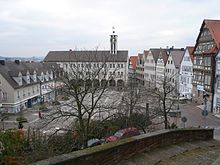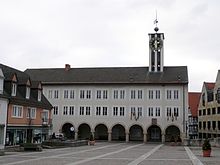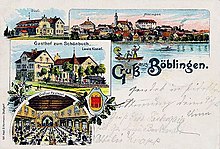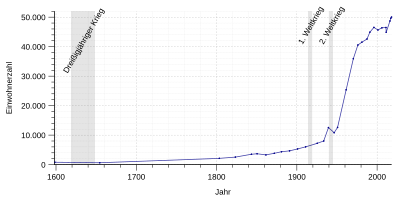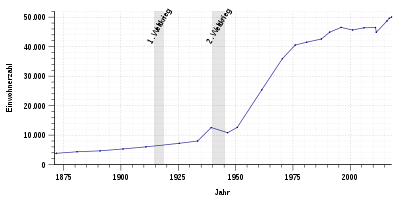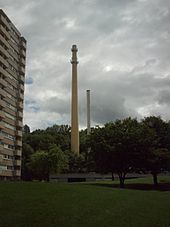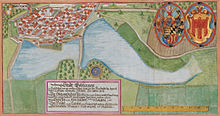Boeblingen
| coat of arms | Germany map | |
|---|---|---|

|
Coordinates: 48 ° 41 ′ N , 9 ° 1 ′ E |
|
| Basic data | ||
| State : | Baden-Württemberg | |
| Administrative region : | Stuttgart | |
| County : | Boeblingen | |
| Height : | 464 m above sea level NHN | |
| Area : | 39.04 km 2 | |
| Residents: | 50,155 (Dec. 31, 2018) | |
| Population density : | 1285 inhabitants per km 2 | |
| Postcodes : | 71032, 71034 | |
| Area code : | 07031 | |
| License plate : | BB, LEO | |
| Community key : | 08 1 15 003 | |
| LOCODE : | DE BWU | |
City administration address : |
Marktplatz 16 71032 Boeblingen |
|
| Website : | ||
| Lord Mayor : | Stefan Belz ( Alliance 90 / The Greens ) | |
| Location of the city of Böblingen in the district of Böblingen | ||
Böblingen [ ˈbøːblɪŋən ] is a district town in central Baden-Württemberg , about 20 kilometers southwest of Stuttgart . Böblingen is the second largest city in the Böblingen district . Together with Sindelfingen , it forms a middle center for the surrounding communities. Böblingen has been a major district town since February 1, 1962 .
geography
Geographical location
Böblingen is located on the northeastern edge of the Upper Gäus , on and on a steep hill that is an offshoot of the Schönbuch . The northern Black Forest can be reached from Böblingen in about half an hour, the Swabian Alb in 40 minutes.
Neighboring communities
The following cities and municipalities border the city of Böblingen. They are named in a clockwise direction starting in the east: Leinfelden-Echterdingen (district Esslingen) as well as Schönaich , Holzgerlingen , Ehningen and Sindelfingen (all district Böblingen)
City structure
Böblingen consists of the core city and the Dagersheim district , which was incorporated as part of the regional reform on September 1, 1971 . In Dagersheim there is a newly elected by the population in each municipal Ortschaftsrat , which a mayor projects.
In the core city, a distinction is sometimes made between residential areas with their own names, the names of which have emerged in the course of history due to the development, but which are usually not exactly delimitable and do not form their own administrative units. These include, for example, Tannenberg, Waldburg, Rauher Kapf, Grund and Diezenhalde.
Spatial planning
Together with the neighboring town of Sindelfingen, Böblingen forms a medium-sized center within the Stuttgart region , the regional center of which is Stuttgart. In addition to the two cities, the central area Böblingen / Sindelfingen also includes the municipalities in the central part of the district of Böblingen, namely Aidlingen , Altdorf , Ehningen , Gärtringen , Grafenau , Hildrizhausen , Holzgerlingen , Magstadt , Schönaich , Steinenbronn , Waldenbuch and Weil im Schönbuch .
Division of space

According to data from the State Statistical Office , as of 2014.
history
prehistory
The settlement of the Böblingen area goes back to the Paleolithic Age (approx. 25,000–20,000 BC). Remains of a mammoth found here show traces of human processing. Traces of settlement and barrows originate from the Bronze Age (approx. 1100 BC) and the Celtic Age (late Hallstatt or Latène period; approx. 400 BC).
middle Ages
The first written records come from the Middle Ages around 1100 AD: "Bebelingen" is mentioned as the name of an Alemannic noble family. The final syllable -ingen in the name of Böblingen refers to the Alemanni . The first part of the city name is associated with a nobleman named "Bobilo".
In 1272, a branch of the Count Palatine of Tübingen , to whom the city was founded, resided in Böblingen . They planned the city in the shape of a half oval around the Schlossberg, with Marktstrasse as the longitudinal axis and cross streets running at right angles to it. The rule of the Tübingen Count Palatine ended in 1344 and 1357, respectively, when economic decline forced them to sell the city to the Counts of Württemberg .
Württemberg time
As a result, Böblingen became the seat of a Württemberg "office" and later an " upper office ".

Before that, there was a castle at the site of the Böblingen Castle. Based on ceramic finds, its construction is dated to the 7th to 9th centuries. The castle was first mentioned in a document in 1302. The castle became the widow's seat of the House of Württemberg in the 15th century . The most important of the princely widows who resided there were Countess Mechthild von der Pfalz , mother of Count Eberhard im Bart from Württemberg , and Barbara Gonzaga von Mantua , Eberhard's wife. The castle shaped the cityscape until it was destroyed in World War II.
On May 12, 1525, Böblingen was the scene of one of the bloodiest battles of the German Peasants' War . Georg Truchsess von Waldburg-Zeil , general of the Swabian Federation , defeated 15,000 farmers from Württemberg, the Black Forest and the Hegau.
The Oberamt Böblingen was created in 1758 from the Württemberg bailiwick and the later office in Böblingen . Due to the upheavals during the coalition wars and the establishment of the Kingdom of Württemberg in 1806 , the Oberamt Böblingen was enlarged by some formerly clerical and imperial knightly areas as well as by other Württemberg places.
In 1850 the city of Böblingen had 3,665 Protestant residents, nine professed to be Catholic and seven to be Jewish. They lived and worked in 482 main and 126 auxiliary buildings. At that time, agriculture and forestry were still the most important sources of income; 35% of the marking area was used for agriculture and 58% was forested. In addition to handicrafts and weaving, which was changing from manual to industrial production, the first industrial operations such as the laboratory of the pharmacist Bonz emerged, which in the 19th century developed into a world-class factory for chemical products, especially for anesthetics , and Spinning mills and Christian Auberlen's toy factory.
At the dawn of the industrial age , the diverse craft, the hard work, the skill and the ingenuity of the people were a locational advantage. The August Wagner machine factory (construction of presses, sewing machines, steam machines and barrel washing machines for breweries) was a prime example of Swabian tinkering. Böblingen's industrial development received the decisive impetus in 1879 with the opening of the Gäubahn . The construction of this line to expand the network of the Württemberg railway was carried out with considerable commitment by Otto Elben . The railway connection was accompanied by the designation of new industrial areas. The mechanical tricot weaving mill Ludwig Maier & Genieder established itself there as early as 1886 . The entrepreneurial concept for success consisted in the production of the newly launched brassiere .
During the First World War , the Böblingen military airport was inaugurated on August 16, 1915. The airport also housed the Aviation Replacement Department 10 (FEA 10) as a training department. The revolution began in Böblingen on the evening of November 8, 1918. Workers at the airport and the Daimler factory in Sindelfingen, which at the time was an aircraft factory and had been under military control since March 1918, planned demands and actions. On the morning of November 9th, after a stoppage of work, the airport workers presented their demands: Improvement of the diet, increase of wages and the dismissal of the yard officer Zahn. Then the civilian workers at the airport, members of the FEA 10 and the employees of the Daimler plant joined together in a demonstration march in the direction of Böblingen, which ended without incident at the Postplatz. FEA 10 soldiers formed a fourteen-member soldiers' council on November 11th . The council ordered the occupation of strategically important institutions. This included the Oberamt , the town hall, the post and telegraph office, the commercial bank, the gas works and the train station. In December the workers and farmers council for the city of Böblingen was elected. With the political change to the republic, the councils lost their importance and disbanded. In May 1919 local council elections took place in Böblingen. In June, the airport ceased operation of the FEA 10, as did the soldiers' council; in the same year, Daimler switched production to car bodies at the Sindelfingen location.
Subsequently, it was of decisive importance for the further urban development that Böblingen became the seat of the state airport for Württemberg in 1925 . Böblingen was the "bridge to the world". On the edge of the airfield, the Böblingen aviation pioneer Hanns Klemm (1885–1961) established his company Leichtflugzeugbau Klemm at the end of 1926 , which was the city's most important industrial company until the Second World War.
A steam brick was also once located in Böblingen. Numerous roof tiles were made here under the direction of authorized officer Alois Reinold, which still cover the roofs of the older houses in Böblingen and Sindelfingen.
Nazi era
By the circular reforms during the Nazi era in Württemberg in 1934 from the upper office Böblingen first of Böblingen , from 1938, the district of Böblingen emerged.
From 1936 the Hindenburg and Ludendorff barracks (today US tank barracks) were built in the city forest in record time, and on April 9, 1938 the 8th Panzer Regiment set up in Zossen moved into it.
The air raid by Allied air forces on the night of October 7th to 8th 1943 destroyed most of the old town with the town church, the castle and the town hall. There were numerous dead and injured. This and other bombing raids destroyed around 40 percent of the built-up area and almost 2,000 people were homeless at the end of the war.
post war period
In 1945 the district town of Böblingen came under the American zone of occupation and belonged to the newly established state of Württemberg-Baden , which was incorporated into the current state of Baden-Württemberg in 1952.
After the currency reform of June 20, 1948, dynamic reconstruction began . The population tripled in just two decades (1950: 12,600; 1970: 37,500). With the settlement of future-oriented companies such as IBM (1949) and Hewlett-Packard (1959) as well as medium-sized companies, which have mainly settled on the Hulb since the 1970s , strong economic growth set in parallel to the population increase .
The population of Böblingen exceeded the limit of 20,000 in 1957. As a result, the city administration applied for a major district town , which the state government of Baden-Württemberg then decided with effect from February 1, 1962. The plan to merge with the neighboring town of Sindelfingen as part of the community reform at the beginning of the 1970s failed due to popular resistance.
From July 19 to 27, 1981 the VIIth International Fire Brigade Competitions of the CTIF (Fire Brigade Olympiad) were held in Böblingen . In 1996 Böblingen organized a state horticultural show that was used to upgrade the inner-city green spaces. On May 25, 2009, the city received the title “ Place of Diversity ” awarded by the federal government .
Incorporations
On September 1, 1971, the previously independent community of Dagersheim was incorporated.
Population development
The population figures are estimates, census results (¹) or official updates from the respective statistical offices ( main residences only ).
|
|
|
|
¹ census result
Religions
The population of Böblingen originally belonged to the diocese of Constance and was subordinate to the archdeacon "ante nemus".
Protestant church
Since the city belonged to Württemberg early on , the Reformation was introduced here by Duke Ulrich from 1535 , so Böblingen was a predominantly Protestant city for centuries. At that time the city became the seat of a deanery (see church district Böblingen ), whose deanery church is the town church. The parish of Böblingen grew strongly after the Second World War as a result of immigration and was therefore divided. The Martin Luther congregation (church from 1960) and the Paul Gerhardt congregation (church from 1962) and in 1990 an ecumenical community center with the Protestant Christ Church and the Catholic parish “Our Father” in the Diezenhalde residential area were established. The four Protestant parishes (City, Martin Luther, Paul Gerhardt and Christ Church) together form the entire Evangelical Church Community of Böblingen. The Reformation was also introduced in the Dagersheim district as it belonged to Württemberg at an early stage. The local evangelical parish celebrates its services in the Agathenkirche, built in the 15th century, which has belonged to the University of Tübingen since 1476. Like all Böblingen parishes, the community belongs to the Böblingen church district within the Evangelical Church in Württemberg .
Catholic Church
Catholics have only returned to Böblingen since the late 19th century. A separate church of St. Boniface was built for them from 1895 to 1899. In 1910 Böblingen became its own parish . A second Catholic church (St. Clement) was built in 1959, which was raised to a parish in 1961. The Church of St. Mary was built in 1963 and made a parish in 1965. In 1990 the “Our Father” congregation in Diezenhalde was established as an ecumenical congregation center with the Evangelical Church. All parishes form the common pastoral care unit 2. The Christkönig church was built in 1958 in the Dagersheim district and in 1961 elevated to a parish. This community forms together with the Sindelfingen communities "Resurrection of Christ", "Maria Queen of Peace" and "To the Holy Trinity" a joint pastoral care unit 9. Both pastoral care units belong to the Böblingen dean's office of the Rottenburg-Stuttgart diocese .
Other denominations
In addition to the two large churches, there are also free churches and congregations in Böblingen , including the South German Community , the Evangelical Methodist Church , the Evangelical Free Church Congregation ( Baptists ), the Free Evangelical Congregation , the Adventist Church and the People's Mission of Determined Christians e. V.
The New Apostolic Church and Jehovah's Witnesses are also represented in Böblingen.
politics
Municipal council
In Böblingen, the municipal council is elected using the spurious selection process . The number of local councils can change due to overhang mandates . The municipality council in Böblingen has 33 members after the last election (unchanged). The local elections on May 26, 2019 led to the following final result. The municipal council consists of the elected voluntary councilors and the mayor as chairman. The mayor is entitled to vote in the municipal council.
| Parties and constituencies |
% 2019 |
Seats 2019 |
% 2014 |
Seats 2014 |
Local elections 2019
% 30th 20th 10
0
22.69%
20.56%
20.48%
15.58%
9.63%
5.11%
3.28%
2.69%
Gains and losses
|
|
| GREEN | Alliance 90 / The Greens | 22.69 | 7th | 15.82 | 5 | |
| CDU | Christian Democratic Union of Germany | 20.56 | 7th | 32.35 | 11 | |
| FW | Free voters Böblingen | 20.48 | 7th | 23.41 | 8th | |
| SPD | Social Democratic Party of Germany | 15.58 | 5 | 21.41 | 7th | |
| FDP | Free Democratic Party | 9.63 | 3 | 7.01 | 2 | |
| BfB | Citizens for Böblingen | 5.11 | 2 | - | - | |
| LEFT | The left | 3.28 | 1 | - | - | |
| AfD | Alternative for Germany | 2.69 | 1 | - | - | |
| total | 100.0 | 33 | 100.0 | 33 | ||
| voter turnout | 52.51% | 40.81% | ||||
mayor
At the top of the city of Böblingen, mayors and a council have been named since the 14th century. There were two mayors, one of whom was elected by the judges from the council and the other by the councilors from the court.
Since the 19th century, the mayor has been called Stadtschultheiß, since 1930 mayor, and when it was elevated to the status of a major district town on February 1, 1962, the official title was mayor . This is elected directly by the electorate for 8 years. He is chairman of the municipal council. His general deputies are the first alderman with the official title of First Mayor and the alderman with the official title of mayor.
Stefan Belz ( Bündnis 90 / Die Grünen ) has been Lord Mayor of Böblingen since April 3, 2018 .
In the election on February 4, 2018, Stefan Belz was elected with 51.3% in the first ballot. The incumbent Wolfgang Lützner ( CDU ) received 28.24% of the votes cast. Belz took office on April 3, 2018.
badges and flags
| Banner, coat of arms and flag | |

|

|

|
|
The coat of arms of the city of Böblingen shows a three-lobed red flag in gold, which goes back to the rule of the Count Palatine of Tübingen . The Böblingen city flag, derived from the coat of arms, is red and yellow. Coats of arms and flags have been used for many centuries.
The coat of arms is very similar to the coat of arms of the federal state of Vorarlberg.
The district of Böblingen-Dagersheim , which was an independent municipality until 1971, also has its own historical coat of arms, which is still used today alongside the city coat of arms of the core town of Böblingen. It shows a crowned red snake with a simply twisted body; the animal's outstretched tongue is black and forked. The background of the animal is formed by a white three-lobed mountain range, between which the multi-jagged Dagersheimer Morgenstern (Dagersheim - “day-appear!”) Rises. The coat of arms composition goes back to the late Middle Ages.
Town twinning
Böblingen maintains a city partnership with the following cities :
-
 Pontoise (France), since 1956
Pontoise (France), since 1956 -
 Geleen , Sittard-Geleen (Netherlands) since 2001 , since 1962
Geleen , Sittard-Geleen (Netherlands) since 2001 , since 1962 -
 Bergama ( Turkey ), since 1967
Bergama ( Turkey ), since 1967 -
 Glenrothes, Fife Region , Scotland, since 1971
Glenrothes, Fife Region , Scotland, since 1971 -
 Krems an der Donau (Austria), since 1972
Krems an der Donau (Austria), since 1972 -
 Alba (Italy), since 1985
Alba (Italy), since 1985 -
 Sömmerda (Thuringia), since 1988
Sömmerda (Thuringia), since 1988
To mark the 20-year partnership anniversary donated Böblingen in 1991 the Scottish sister city Glenrothes statue The Defenseless One (German The defenseless ) made by the German sculptor and native Böblinger Rudolf Christian Baisch was created (1903 to 1990). The cast bronze statue on a stone pedestal was placed in Riverside Park in Glenrothes.
Sports
The SV Böblingen is Böblingen's largest sports club with over 7,000 members in 25 departments.
In March 1997 "The Wild South" was founded. Ten of the best rock 'n' roll couples in the A class from all over Baden-Württemberg joined forces. "The Wild South" has become world champion seven times.
There are many sports clubs in Böblingen, including, for example, an ambitious riding club.
From 1949 until 1963. existed east of Böblingen at '' 59 ° 48 41 N , 9 ° 2 '2 " O a ski jump, the Kurt-Beuttler hill. It was a 17 meter high wooden structure with a run-up length of 40 meters. Competitions were regularly held on it, but it was demolished in 1963 because it was hardly used after numerous winters with little snow and fell into disrepair. Today only the run-off slope remains of the former ski jumping facility, at the end of which there is a barbecue area.
Economy and Infrastructure
In the Future Atlas 2016, the district of Böblingen was ranked fourth out of 402 districts and urban districts in Germany, making it one of the districts with “top future opportunities”.
traffic
Streets
Böblingen is easily accessible on all transport routes: Stuttgart Airport can be reached in around 20 minutes by S-Bahn.
The intersection between the federal highways 8 and 81 (Karlsruhe – Munich / Singen – Heilbronn) is not far northeast of Böblingen. The A 81 passes in the north of the urban area. The city can be reached via the interchanges Böblingen-Ost, Böblingen / Sindelfingen, Böblingen-Hulb and Ehningen. The federal highway 464 ( Renningen - Reutlingen ) and the B 14 pass Böblingen.
Railways and buses
The station Böblingen combines three different railway lines:
- The most important is the Gäubahn from Stuttgart to Singen and is served hourly by regional and city express trains. In addition Böblingen is with the lines S1 Kirchheim (Teck) -Stuttgart- Herrenberg to the path S-network Stuttgart connected. The S-Bahn stations Goldberg and Hulb are located in the city area of Böblingen and are served by the S1. You can reach Stuttgart in about 25 minutes.
- In 1996 the Schönbuchbahn to Dettenhausen was reactivated. The Schönbuchbahn serves the Danziger Straße, Böblingen-Süd, Heusteigstraße and Zimmerschlag stops in the Böblingen urban area. A branch line from today's Böblingen Zimmerschlag station to Schönaich was in operation between 1922 and 1959, but is now partially built over, and there are no plans to reactivate this line.
- The double-track Rankbachbahn to Sindelfingen and Renningen was put into operation in 2012 as the S60 S-Bahn, it is also used for freight traffic.
In the urban area of Böblingen and Sindelfingen, numerous city bus routes are operated by the Pflieger company , as well as several overland routes. All lines operate at uniform prices within the Stuttgart Transport and Tariff Association (VVS).
The long-distance bus network includes connections to Hamburg and Milan.
Air traffic
The nearest international airport is Stuttgart Airport and is only a few kilometers away and can be easily reached via the motorway and S-Bahn. Böblingen Airport used to be located in the city area, some of the former airport buildings are still preserved, the Flugfeld district is located on the former airport area .
Local businesses
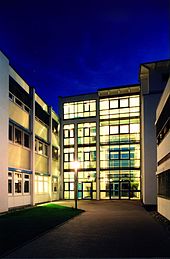
- Computer industry: Compart, Agilent , Hewlett-Packard , Keysight Technologies , IBM , Kroll Ontrack , Microsoft , Philips Germany , Siemens , Softpro , Softwarezentrum Böblingen / Sindelfingen , Advantest Corporation (formerly Verigy Ltd.)
- Automotive industry: Daimler AG , Smart , Lear , Elektrobit Automotive GmbH
- Media: C&L Verlag
- Aerospace industry: Moog GmbH
- Financial services: Kreissparkasse Böblingen , Vereinigte Volksbank eG
- Beverage industry: Schönbuch Bräu
- Solar industry: AXITEC GmbH
- Plant construction: Eisenmann AG
- Trade: Plana Küchenland , Reisser AG
- Energy supply: Stadtwerke Böblingen
- Pharmaceutical company: Wörwag Pharma
media
The regional television broadcaster Regio TV Stuttgart was based in Böblingen until 2010. This broadcasts the regional magazine in a half-hour rotation every day from 6 p.m. to 2 a.m., with news and articles from the districts of Böblingen, Rems-Murr, Ludwigsburg, Göppingen and Stuttgart. The daily newspapers in Böblingen are the district newspaper Böblinger Bote , the Böblinger Zeitung , a local edition of the Sindelfinger Zeitung as well as the national daily newspapers Stuttgarter Zeitung and the Stuttgarter Nachrichten , each with a local section for the city and the district of Böblingen. In addition, the PIG city magazine Böblingen / Sindelfingen appears every month.
Retail (supra-regionally significant)
Since the completion of the shopping center between the old town and the train station in the 1960s, Böblingen has also been important as a shopping town for the surrounding communities (and the equally large Sindelfingen). The heart of the first shopping center was a Hertie department store. Another building complex, the city center , was added at the end of the 1970s . The emphasis for customers from the region shifted significantly with the opening of the Breuninger Land in Sindelfingen. The end of 2014 was at the station - in the lower city , the - Mall Mercaden opened. In spring 2015, Bahnhofstrasse, which had been transformed into a pedestrian zone, was reopened as a “promenade”.
Authorities, courts and institutions
As a district town, Böblingen houses the district office and most of the district's offices. Böblingen also has a tax office and a district court that belongs to the regional court and OLG district of Stuttgart .
The city is also the seat of the Böblingen church district of the Evangelical Church in Württemberg and the Böblingen deanery of the Rottenburg-Stuttgart diocese .
The Stuttgart Federal Police Directorate is based in the former Wildermuth barracks in Boeblingen . The area of responsibility extends to the federal state of Baden-Württemberg. It guarantees with its seven subordinate federal police inspections u. a. the protection of railway facilities, the Schengen internal border with France and Switzerland, Stuttgart Airport and the Federal Constitutional Court .
Supraregional offices of the Baden-Württemberg Police - based in Böblingen - are the 5th Riot Police Directorate Böblingen and the Baden-Württemberg State Police Orchestra .
military
In Böblingen there is a barracks of the US armed forces ( Panzerkaserne Böblingen ) in which Green Berets of the “10th Special Forces Group, 1st Battalion (Airborne)” are stationed. It is also the headquarters of the United States Marine Corps Forces Europe (see also: Foreign military bases in Germany ). The American base at the old airport, formerly a repair facility ( English Maintenance Facility ) for military vehicles of all kinds within the VII. US Corps and branch of the tank barracks, which together formed the so-called Boblingen-Sindelfingen Military Community , was closed in autumn 1991 . The site is currently being re-used. On February 7, 2007, Germany's largest American supermarket, "Panzer-Exchange", was opened in the Böblinger Panzerkaserne. On 13,200 m², only members of the troops and NATO can get supplies from multimedia, cosmetics and vitamin products to pet supplies. The "Sport Recreations Center" can also be found here, a kind of leisure organization for the US troops, which also runs the local paintball field .
Educational institutions
The numerous educational and cultural institutions in Böblingen offer a wide range of options. Secondary and vocational schools with a wide catchment area, in conjunction with the city library, the music and art school and the adult education center, form a wide range of training and further education as well as on-site leisure activities.
In Böblingen there are four general high schools ( Albert-Einstein-Gymnasium , Lise-Meitner-Gymnasium , Max-Planck-Gymnasium and Otto-Hahn-Gymnasium) , two secondary schools (Albert-Schweitzer- and Friedrich-Schiller-Realschule), one special school (Pestalozzischule), a primary and technical secondary school (Eichendorff-GWRS), a secondary secondary school (Theodor-Heuss-WRS), six pure primary schools in the core city (Eduard-Mörike-, Erich-Kästner-, Friedrich-Silcher-, Justinus-Kerner -, Ludwig-Uhland- and Wilhelm-Hauff-Schule) as well as an elementary school in the Dagersheim district.
The Böblingen district is responsible for the three vocational schools ( Academy for Data Processing Böblingen - ADV; Commercial School Center Böblingen - KSZ-BB, including a business school ; Mildred Scheel School Böblingen, including a biotechnological grammar school and a nutritional grammar school). The Käthe Kollwitz School for the mentally handicapped with a school kindergarten for the mentally handicapped should also be mentioned here.
The Free Evangelical School Böblingen e. V. (elementary, secondary and secondary school), the Free Waldorf School Böblingen / Sindelfingen e. V. (elementary school to high school graduation), the private elderly care school of the Arbeiterwohlfahrt Nordwürttemberg e. V. and the private vocational school in the Böblingen educational center of the International Federation e. V. round off the school offer in Böblingen.
Adult education is offered by vhs.Böblingen-Sindelfingen e. V. and the Association for the Promotion of Vocational Training e. V., an educational institution of the IHK .
Residual waste thermal power station
To the east of Böblingen, in a 40 meter high building, there is a residual waste cogeneration plant with a generating capacity of 12 MW. The chimney of the residual waste cogeneration plant is 55 meters high. The net heat output of the system equipped with 2 lines, which can burn 9.43 tons of residual waste per hour, is 48.4 MW.
Culture and sights
Buildings and cultural monuments
- The Evangelical parish church of St. Dionysius on the market square is the city's landmark . The tower of the church was built when the city was founded, the nave in the 14th century. The church was destroyed in World War II and then rebuilt.
- The Evangelical Agathenkirche in Böblingen-Dagersheim is as old as the town church, ship and choir were renewed in their current form in 1491. The nave holds 500 people. The wooden choir stalls show valuable carvings from the 15th century. The 36 meter high fortified tower can be seen from afar, the historic cone chest organ by Carl Gottlieb Weigle from 1857 is the oldest playable organ in the whole region.
- Other larger churches in Böblingen are the Paul Gerhardt Church, built in 1960/61 for the Protestant parish in Weststadt, and the Martin Luther Church, built in 1959/60 for Protestant believers in the Oststadt.
- From 1963 to 1966 , Hans Scharoun created a housing estate consisting of seven houses on the Rauhen Kapf , and in 1971 his Orplid , one of his last high-rise buildings with remarkable architecture, in the west of the city.
- The 82 meter high chimney of the district heating plant built in 1978 on Ernst-Reuter-Strasse is the tallest structure in the city.
- The 31 meter high water tower on the Waldburg was built in 1928 and has a 28 meter high viewing platform.
Museums and galleries
- The Zehntscheuer , built in 1593, now houses the Böblingen Municipal Gallery and the Peasant War Museum . The Peasant War Museum also documents the Battle of Böblingen from 1525 and contains a pewter figures diorama .
- The gallery contact is a municipal exhibition space for regional artists and Böblingen art associations as well as culturally active groups from Böblingen.
- In the building of the old local court, built in 1833 - today the seat u. a. of the Böblinger Kunstverein - there is Schleuse 16 , an exhibition room for preferably experimental art.
- The German Meat Museum is located in a half-timbered house (with wall paintings inside) in the city center.
- The local history museum of the North Bohemian Netherlands is housed in the German Butcher Museum Böblingen. The focus of the collection is on models of landscapes and houses, tools, traditional costumes and memorabilia from the North Bohemian Netherlands.
Lakes
In the course of the State Horticultural Show in 1996, the area around the "Upper" and "Lower" lakes was generously redesigned. The "Long Lake" was created in the Flugfeld area and flooded in 2010.
Regular events
- City festival ("Böblinger Jahrmarkt") in July, which takes place around the Schlossberg.
- Since 1996 the “Böblinger Sommer am See” has been taking place annually from June to September with over 60 individual events (e.g. concerts, flea market, feasting on the lake, etc.) around the newly designed lakes.
- Concerts and events took place regularly in the now demolished sports hall and in the congress hall ( Wetten, dass ..? , Do you understand fun? ).
- Parade on Rose Monday: Annually on Rose Monday, organized by Grün-Weiß Böblingen e. V. Local groups move through the city with many foreigners and music groups.
- The fish soup dinner takes place on Ash Wednesday. The profit from this event will be used for the benefit of multiple sclerosis sufferers and other humanitarian organizations.
- The "Böblinger Open", an open chess tournament, attracts over 300 chess players from all over Europe to Böblingen every year from December 26th to 30th.
Mineral thermal baths Böblingen
A salty mineral thermal spring developed at a depth of 775 m feeds the mineral thermal baths in Böblingen, which offers relaxation, wellness and health programs.
The thermal water flows in three indoor and two outdoor pools with temperatures from 31 ° C to 36 ° C, in a whirlpool and bubble loungers. There is also a 1400 m², planted sauna garden with several saunas and steam baths. The mineral thermal bath was opened in 1989. Previously there were car workshops and car dealerships here.
Personalities
literature
- Erich Keyser (Ed.): Württembergisches Städtebuch. Volume IV: Sub-volume Baden-Württemberg, Volume 2 from the German city book. Handbook of urban history - on behalf of the working group of historical commissions and with the support of the German Association of Cities, the German Association of Cities and the German Association of Municipalities, Stuttgart 1961.
- Andreas Wiedenmann and the Evangelical Church Congregation Dagersheim (editor-in-chief): Kleiner Dagersheimer Kirchenführer. Festschrift for the 500th anniversary of the Dagersheim Church , Böblingen 1991.
- Sönke Lorenz , Günter Scholz (Ed.): Böblingen. From mammoth tooth to microchip . Filderstadt 2003, ISBN 3-935129-09-2 .
- Julius Fekete: Art and cultural monuments in the Boeblingen district . With photos by Joachim Feist. Stuttgart 2006, ISBN 978-3-8062-1969-2 .
Web links
Individual evidence
- ↑ State Statistical Office Baden-Württemberg - Population by nationality and gender on December 31, 2018 (CSV file) ( help on this ).
- ↑ State Statistical Office, area since 1988 according to actual use for Böblingen.
- ↑ Description of the Upper Office Böblingen - Table I.
- ↑ Christoph Florian: Revolution in Böblingen: November 9, 1918 . In: Stadt Böblingen (Ed.): Official Journal Böblingen . No. 46 . District newspaper Böblinger Bote Wilhelm Schlecht GmbH & Co.KG, Böblingen November 16, 2018, p. 8 ( Current Official Gazette from: November 16, 2018 ).
- ↑ The Hulb. Retrieved April 2, 2018 .
- ^ Federal Statistical Office (ed.): Historical municipality directory for the Federal Republic of Germany. Name, border and key number changes in municipalities, counties and administrative districts from May 27, 1970 to December 31, 1982 . W. Kohlhammer, Stuttgart / Mainz 1983, ISBN 3-17-003263-1 , p. 447 .
- ↑ Election information for the municipal data center
- ^ Röhm Verlag und Medien GmbH & Co. KG: Dr. Stefan Belz clearly wins OB election . February 5, 2018 ( bbheute.de [accessed April 2, 2018]).
- ↑ Stuttgarter Zeitung, Stuttgart, Germany: Böblinger OB election: Wolfgang Lützner is voted out - Stefan Belz creates a sensation . In: stuttgarter-zeitung.de . ( stuttgarter-zeitung.de [accessed on April 2, 2018]).
- ↑ Sports clubs in Böblingen. Accessed January 21, 2020 .
- ^ Böblingen Riding Club. Accessed January 21, 2020 .
- ↑ Thomas Oberdorfer: Long sentences and hard landings . szbz.de. February 9, 2013. Archived from the original on October 22, 2016. Retrieved on February 1, 2019.
- ↑ Zukunftsatlas 2016. Archived from the original ; accessed on March 23, 2018 .
- ^ Ulrich Hanselmann: Mercaden: Böblingen (...). stuttgarter-nachrichten.de, June 22, 2012, accessed on January 16, 2014 .
- ↑ Gerlinde Wicke-Naber: Groundbreaking ceremony - Böblingen becomes a shopping city again. stuttgarter-zeitung.de, November 8, 2012, accessed on January 16, 2014 .
- ↑ Böblingen celebrates the opening of the new pedestrian zone. (No longer available online.) City of Böblingen, April 30, 2015, archived from the original on June 19, 2016 ; Retrieved June 19, 2016 .
- ↑ Water tower on the forest castle . In: Structurae .
- ↑ Nachrichten Kreis-BB, Local: Over 151 steps to a vision ( Memento from December 4, 2014 in the Internet Archive ), szbz.de, December 11, 2012. (The total height in other sources is 31 m)
- ^ Mineral thermal baths Böblingen: Welcome. Retrieved April 2, 2018 .
- ↑ 25 years of mineral thermal baths in Böblingen ( Memento from April 17, 2015 in the Internet Archive )




